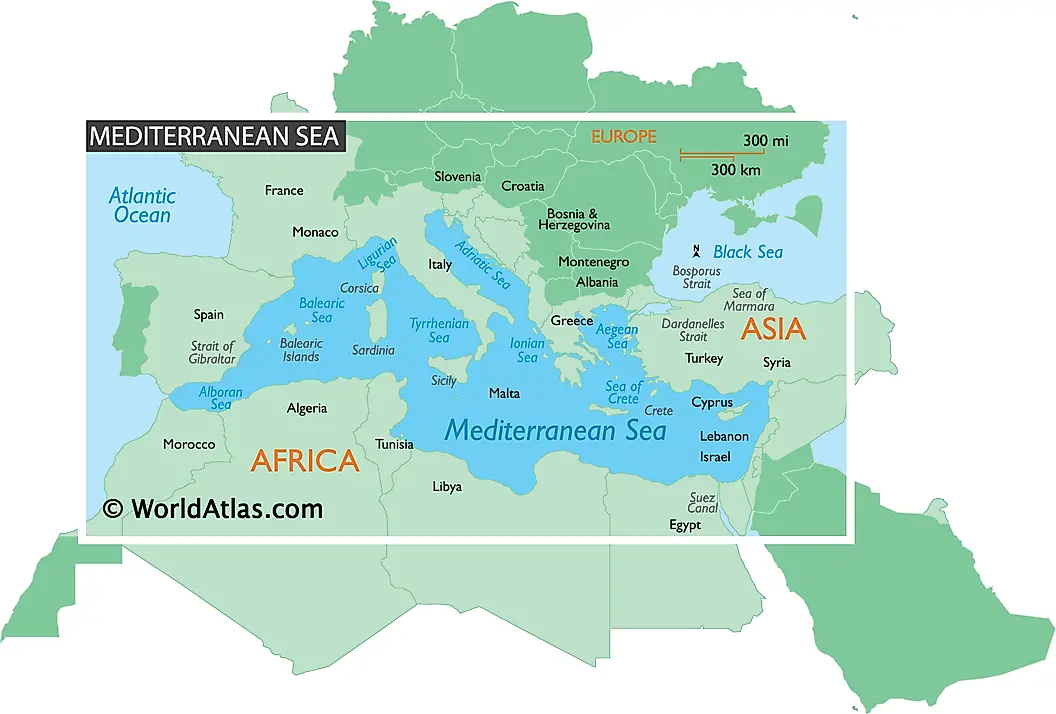Mediterranean Sea Map with Bordering Countries for UPSC CSE
Mediterranean Sea is an important location that you cover while studying Geography and International Relations for UPSC CSE. This page contains the respective map along with notes.

The Mediterranean Sea is a significant body of water that spans three continents: Europe, Africa, and Asia. This intercontinental sea has historical, geographical, and strategic importance, making it a critical topic for the UPSC Civil Services Exam. Understanding the Mediterranean Sea's bordering countries, its geography, and related key facts will help aspirants prepare for map-based questions and geopolitical issues.
Geography of the Mediterranean Sea
The Mediterranean Sea stretches about 4,000 km from the Strait of Gibraltar in the west to the Gulf of Iskenderun on Turkey's southwestern coast. It covers an area of approximately 2.5 million square kilometers. The sea has an average depth of 1,500 meters, with the deepest point, the Calypso Deep, reaching a depth of 5,267 meters in the Ionian Sea.
Key geographical connections include:
- Strait of Gibraltar (west): Links the Mediterranean Sea to the Atlantic Ocean.
- Dardanelles Strait, Sea of Marmara, and Bosphorus Strait (northeast): Connect the Mediterranean Sea to the Black Sea.
- Suez Canal (southeast): Links the Mediterranean to the Red Sea, providing a vital route for global trade.
The Mediterranean Sea is divided into eastern and western portions by a submarine ridge between Sicily and North Africa. The sea's waters are more saline than the Atlantic Ocean, although there is constant water exchange through the Strait of Gibraltar.
Countries Bordering the Mediterranean Sea
The Mediterranean Sea borders 22 countries and one territory, Gibraltar, a British Overseas Territory. The countries are spread across Europe, Asia, and Africa, with several marginal seas within the Mediterranean region.
Europe
- Spain
- France
- Monaco
- Italy
- Malta
- Slovenia
- Croatia
- Bosnia and Herzegovina
- Montenegro
- Albania
- Greece
- Gibraltar (British Overseas Territory)
Africa
- Egypt
- Libya
- Tunisia
- Algeria
- Morocco
Asia
- Türkiye (also spans Europe)
- Cyprus
- Syria
- Lebanon
- Israel
- Palestine (Gaza Strip)
Key Marginal Seas and Bordering Countries
The Mediterranean Sea is further divided into several marginal seas, each bordered by different countries. Some important ones include:
- Alboran Sea: Borders Spain, Morocco, Algeria, and includes Gibraltar.
- Ligurian Sea: Bordered by Italy, France, and Monaco.
- Tyrrhenian Sea: Bordered by Italy and France.
- Ionian Sea: Bordered by Italy, Greece, and Albania.
- Adriatic Sea: Bordered by Italy, Slovenia, Croatia, Bosnia and Herzegovina, Montenegro, and Albania.
- Aegean Sea: Bordered by Greece and Türkiye.
Important Straits and Channels
- Turkish Straits: Includes the Bosphorus Strait and Dardanelles Strait, connecting the Black Sea to the Aegean Sea through the Sea of Marmara.
- Strait of Gibraltar: Connects the Mediterranean Sea to the Atlantic Ocean.
- Suez Canal: A man-made canal linking the Mediterranean Sea to the Red Sea.
Islands in the Mediterranean Sea
The Mediterranean is home to several important islands:
- Sicily (Italy): The largest island in the Mediterranean.
- Sardinia (Italy)
- Corsica (France)
- Crete (Greece)
- Cyprus (Island country)
- Malta (Island country)
- Balearic Islands (Spain)
Rivers Draining into the Mediterranean
Several major rivers flow into the Mediterranean Sea, including:
- Nile (Egypt): The world's longest river.
- Rhone (France)
- Po (Italy)
- Tiber (Italy)
- Ebro (Spain)
- Drin-Bojana (Albania/Montenegro)
These rivers play a significant role in shaping the Mediterranean's geography and the surrounding ecosystems.
Key Historical and Geopolitical Significance
Historically, the Levant region, along the eastern Mediterranean shores, has been vital for trade and cultural exchange. This area corresponds to modern-day Israel, Lebanon, Syria, and parts of Jordan. The region remains geopolitically significant due to ongoing conflicts and territorial disputes.
Strategic Importance for UPSC
For the UPSC exam, the Mediterranean Sea’s bordering countries and its maritime connections are crucial for understanding global trade routes, geopolitical issues, and environmental concerns. The sea is a major route for oil and gas transport, and its strategic location between Europe, Asia, and Africa makes it a hotspot for international relations.
Aspirants should focus on:
- Identifying the countries bordering the Mediterranean and marginal seas.
- Understanding the key straits, channels, and islands.
- Keeping up with current affairs related to Mediterranean geopolitics.
This comprehensive understanding will help tackle geography and international relations questions in the UPSC exam.